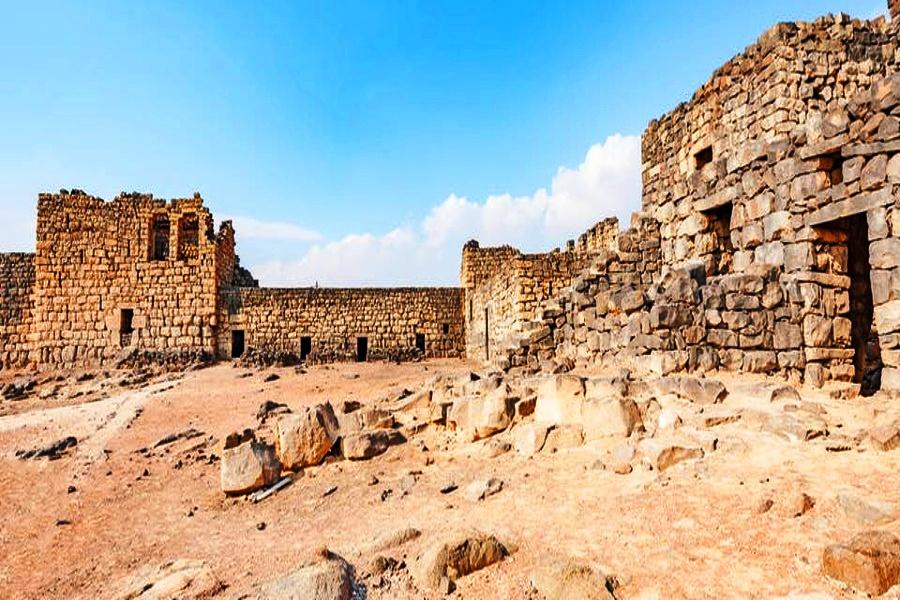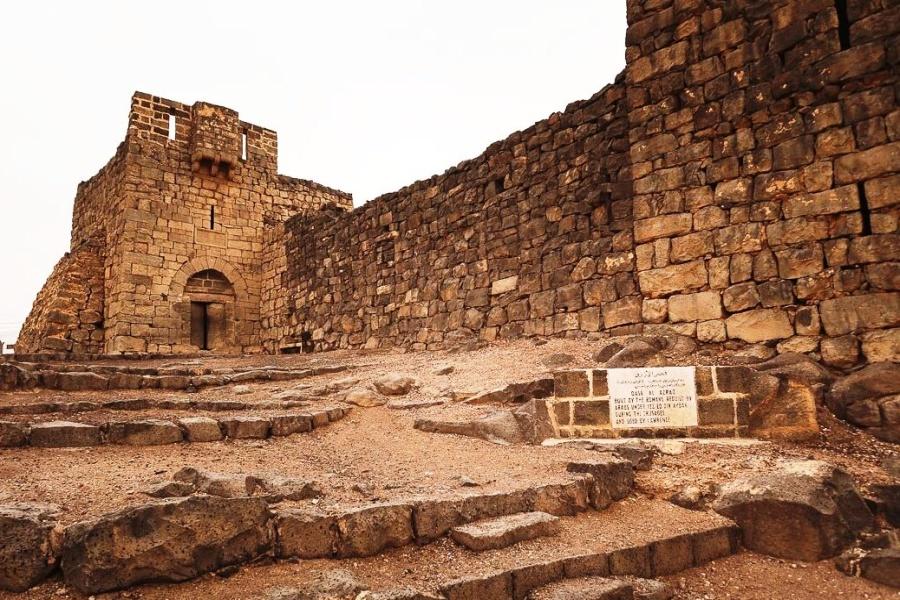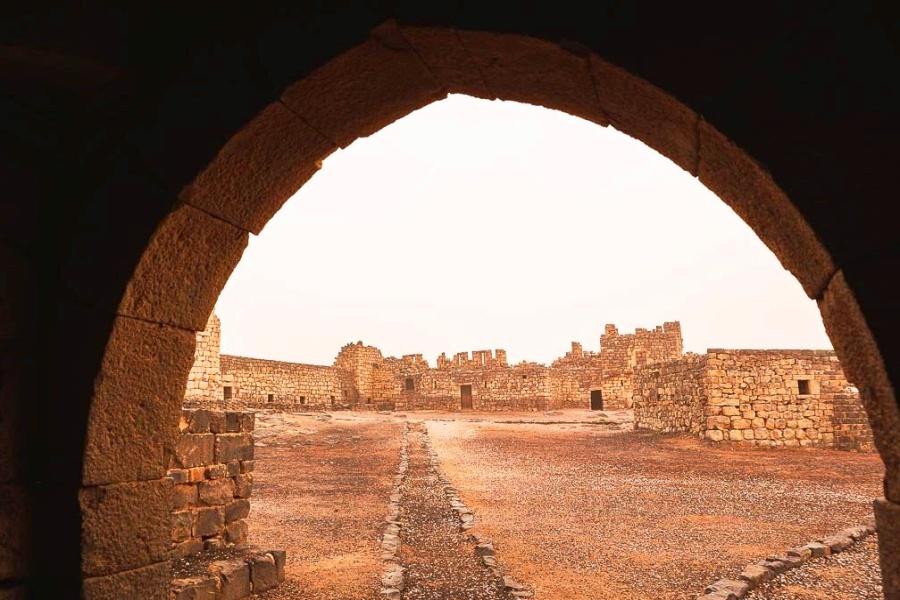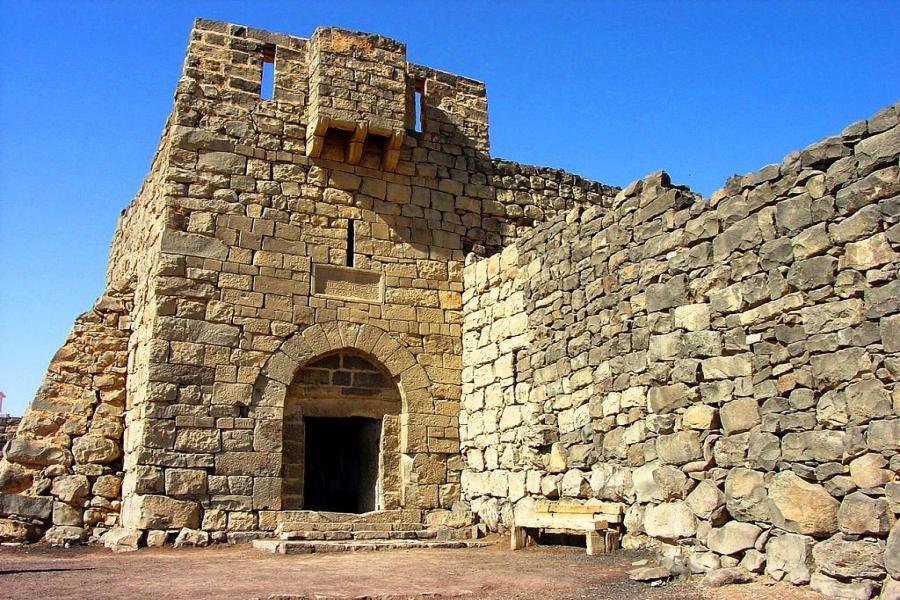+962 7 9635 8199
[email protected]
Тhe best Desert Castle in Jordan. At least if you imagine under the phrase ‘Desert Castle’ an ancient stone-walled fortress located in the eastern part of the country.
The black basalt fort, strategically located in the middle of the Azraq oasis, and on a major desert trade route, has been in continuous use since it was built by the Romans in the 3rd century AD.
Azraq city is situated in central eastern Jordanian desert, and is the point where three separate deserts join together and continue into Saudi Arabia. The castle and the town of Azraq are, approximately 80 kilometers from the city of Amman.
The town of Azraq itself is small and it is situated beside a large highway, the town is very much affected by loud traffic noise. That said if you wish to experience an authentic Jordanian town then Azraq is a great place to spend a night. It is the only area in the region to accommodate foreign visitors with a number of hotels and guesthouses. Due to its roadside position, there are many places to dine.
About 13 kilometres north of the Azraq Junction, on the modern highway to Iraq , you will find the large black fortress of Qasr al-Azraq (The Blue Fortress), Azraq castle is one of desert castles with an ancient stone-walled fortress at the eastern part of the country.


This Roman castle found in the north-east of Jordan, in the major oasis of the region.
The main archaeological studies of the site are attributed to the extended archaeological survey conducted by Kennedy in 1982 onwards and the excavations carried out by the Department of Antiquities between 1977–2008.
The best documented being the excavation directed by Ahmad Lash in 2008. From these studies, it is evident that the actual building was a Roman fort that has undergone important rebuilding and modifications.
Al Azraq strategic value came from the nearby oasis, the only water source of in approximately 12,000 square kilometres in a vast desert region. The name of the fortress and associated town came from these. Qasr al Azraq did not assume its present form until an extensive renovation and expansion by the Ayyubids in the 13th century, using locally quarried basalt which makes the castle darker than most other buildings in the area.
The castle is almost square, with 80-meter local black basalt long walls encircling a central courtyard. In the middle of the courtyard is a small mosque that may date from the Ayyubid period, along with the main well.
At each corner of the outer wall, there is an oblong tower.
The primary entrance is a single massive hinged slab of basalt, which leads to a vestibule where one can see carved into the pavement the remains of a board game.
Above the entrance area is the chamber that was used by Lawrence during his stay in Qasr al-Azraq.
Although very heavy — 1 ton for each of the leaves of the main gate, 3 tons for single the other — these stone doors can quite easily be moved, thanks to palm tree oil.
The unusual choice of stone can be explained by the fact that there is no close source of wood, apart from palm tree wood, which is very soft and unsuitable for building.
The caretaker of the castle has a collection of photographs of Lawrence; in fact, his father was one of the Arab officers who served with the legendary Brit.
Originally, the castle was part of the strong military presence on the defended border which characterized the eastern provinces during the Severian period and intensified under the Tetrarchy, during the 3rd century.
The earliest certain date for the Roman occupation of the oasis is related to Septimio Severus (193–211 AD); however, there is no evidence that directly relates the building to this period, and the oldest certain date of the site, is given by inscriptions found in loco dedicated to Diocletian and Maximilian (287–305 AD).
Another inscription dedicated to Constantine provides evidence, of building refurbishment during the beginning of the Byzantine period.
During the 5th century AD there is no evidence of occupation at Azraq, this can be the result of a period of relative peace with the Persian.


Qasr al-Azraq underwent its final major stage of building in 1237 CE, when the Ayyubids “‘Izz ad-Din Aybak” redesigned and fortified it. In the 16th century the Ottoman Turks stationed a garrison there, and Lawrence of Arabia made the fortress his desert headquarters during the winter of 1917, during the Great Arab Revolt against the Ottoman Empire. His office was in the chamber above the entrance gatehouse. It had an additional advantage in modern warfare: the flat nearby desert was an ideal place to build an airfield.
There are remains from the original 3rd Century AD building including an altar close to the entrance. Visitors can also visit the room of T.E. Lawrence which was constructed with arrow slits and strategic views. The impressive basalt door located in the western tower was made famous by Lawrence in the book Seven Pillars of Wisdom (download) . There is also a 13th Century mosque and the remains of a prison, kitchen and dining room.
Above the entrance is Lawrence’s Room, strategically overlooking the entry and offset with arrow slits for defence. Opposite the entrance, and just to the left, are the remains of an altar, built in the 3rd century AD by the Romans. In the middle of the courtyard is a small mosque, angled to face Mecca – it dates from the Ayyubid period (early 13th century) but was built on the ruins of a Byzantine church. In the northeast corner of the courtyard, a hole with stairs leads down to a well, full of water until about 20 years ago. In the northwest corner are the ruins of the prison.
The northern sections are residential areas with barely discernible ruins of a kitchen and dining room, and nearby storerooms and stables. The tower in the western wall is the most spectacular, and features a huge door made of a single massive slab of basalt. Lawrence describes in his book Seven Pillars of Wisdom how it ‘went shut with a clang and crash that made tremble the west wall of the castle.

From Amman :
Qasr al-Azraq is located approximately 115 kilometers from Amman.
Getting to Qasr Azraq from Amman is pretty straightforward. We recommend to rent a car.
From Azraq :
You can overnight in Azraq and get to the Castle by taxi, that will usually charge around 3-2JD from the city of Azraq.
Alternatively:
Those who do not wish to stay in the town can visit Qsar al-Azraq as part of a day trip from the city of Amman. It is easy to get to and there are many organized tours to the castle from the larger cities.
Desert Castles are included in the Jordan Pass, and Azraq Castle is no exception to this fact.
Otherwise, the entrance fee to Azraq Castle is 1 JD.
To visit the Castle!
Azraq Castle is located directly in Azraq Town. Azraq by it self is a small and remote town in the northeastern part of Jordan, and the reason, why this settlement was built in this place is simple:
In this area, you will find the only permanent source of fresh water in this desert (roughly 12,000 square kilometers).
The castle :
The entrance itself is pretty impressive, there is a massive stone door in the west wall, a rectangular mosque in the middle of the courtyard, and you can also climb the tower near the entrance.
There are actually very few places to stay on the Desert Castles chain.
It’s better to visit desert castles on a day trip from either Amman or cities near the capital such as Jerash or Madaba.
Or to overnight in Azraq town: Azraq Oasis – private villa allows you to stay as close as possible to the desert castles. Azraq Oasis offers comfortable and clean rooms, lovely staff, an outdoor pool, a great breakfast, and a beautiful garden. Probably the best place to get away from the crowds.